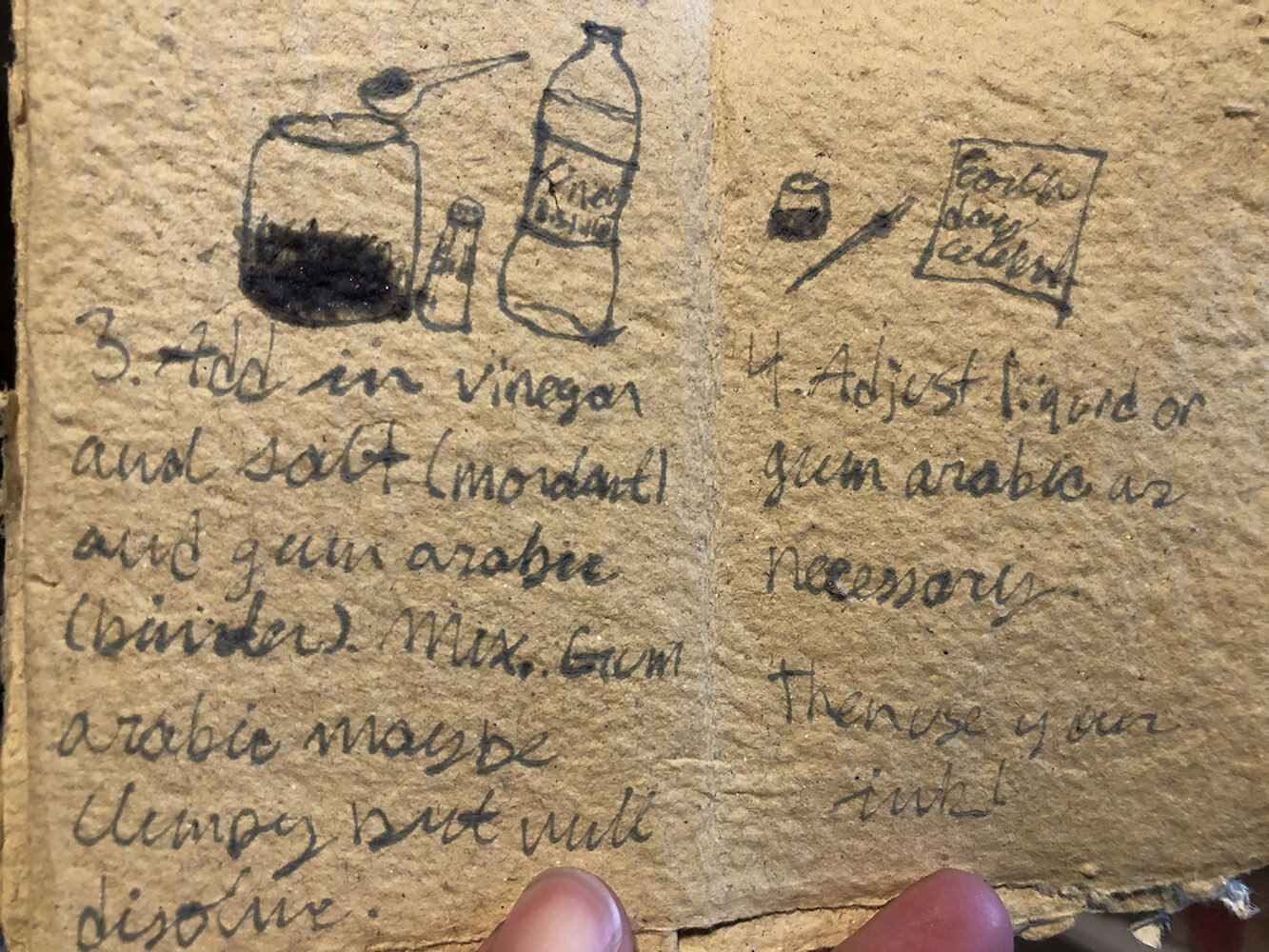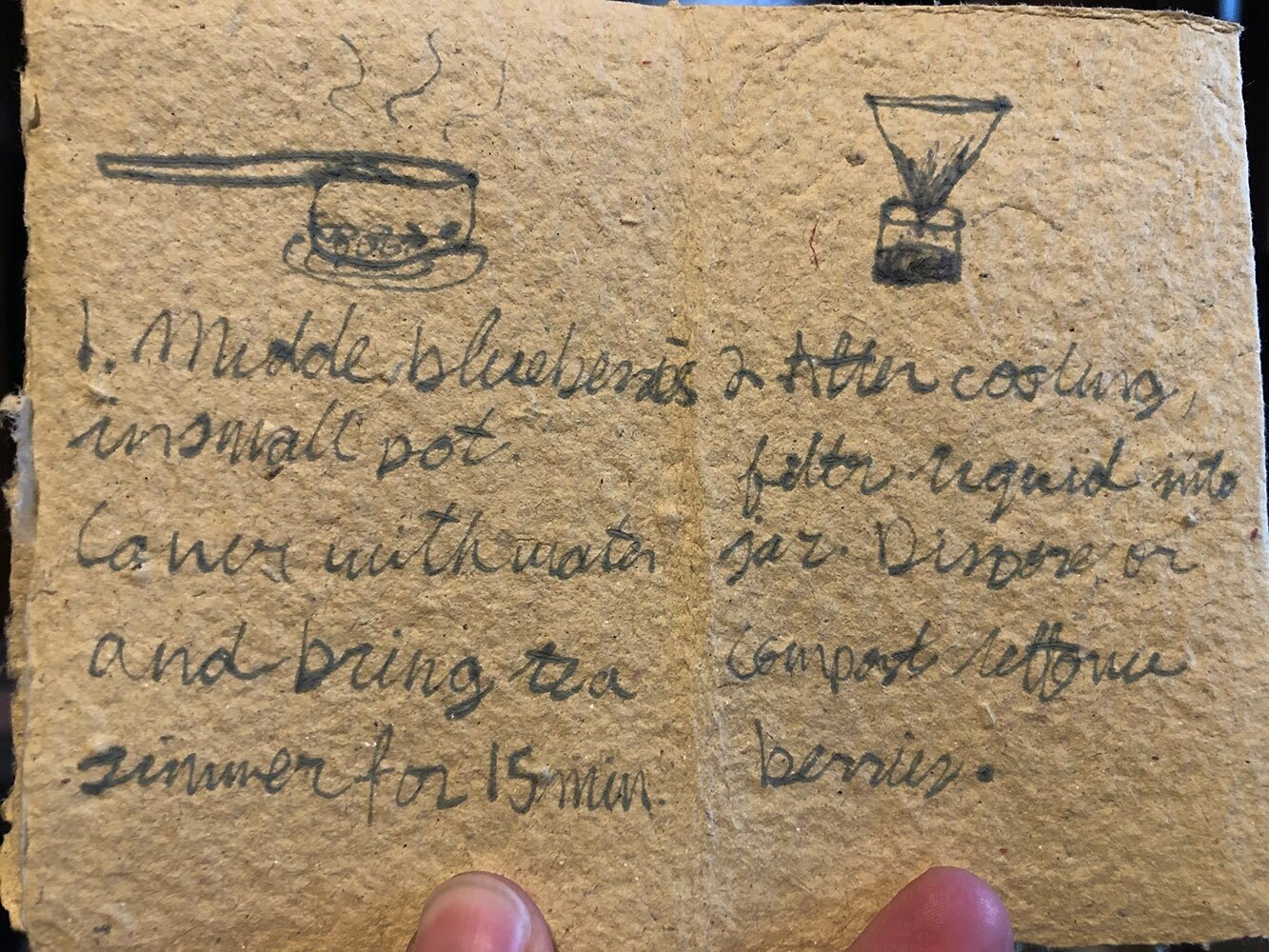Photo by Marie Lerma. Four inks (L to R) onionskin, blueberry black ink, and turmeric/paprika blend. April 17, 2020
Originally, I meant to have this workshop in person in April, however the COVID-19 crisis changed that. The ink-making virtual workshop was inspired by my personal and pedagogical love of zines, as well as my growing interest in creating the mediums in which I can make art. The first draft of this workshop would have involved not only zine-making and ink-making, but the creation of our own plantable paper but I realized that was a little much. Instead, I researched local paper makers and found the delightful White Dragon Paper, a queer paper and journal maker who is local to Columbus. They use recycled materials in order to create paper. They also make Midwest specific wildflower seed paper.
The workshop was hosted virtually on April 22, which is Earth Day. A mix of students, artists, and faculty attended and watched me walk through how inks are made, and then watched me make a blueberry ink. We discussed a brief history of ink making, what the components of ink are, and then the process of creating ink. The participants asked me about different plants that can make ink, and about the different inks I had made. I explained that blueberry ink is what I had the best results with. During the workshop, I experimented with charcoal ink (based off an ancient Roman ink recipe) and black tea ink too. I made this zine after using the blueberry ink.
Photo by Marie Lerma. “How to Make Your Own Ink” mini zine on White Dragon Paper seed paper, using blueberry ink. April 22, 2020
As I write my dissertation, I realize how I've written has changed so much. As a child I used pencils to desperately scribble my thoughts and creative urges in the margins of notebooks during class. I quickly transitioned to computer notes in college because my handwriting is terrible. Then in grad school, I changed to pen and paper again because I liked having a notebook in my hand. But using pens made me think about how little I knew about ink. In childhood I had experimented with paper making either in school or as a Girl Scout, but I never even thought about ink. This workshop idea came at a time where I had a growing interest in DIY. It seemed appropriate to combine my curiosity about ink with the zine project assignment I do with my courses.
I looked at a variety of sources during my research on inks that could be made in my class. The resources I found ranged from Martha Stewart or websites about natural products and living, to historical calligraphy, to hardcore pen enthusiasts, and even survivalists. The process of ink-making can be simple or very complex, depending on what you want your outcome to be. I did a few rounds of experimenting on my universal recipe, adapted from the resources I used, to see how difficult it was to make an ink that was productive.
Photo by Marie Lerma. Filtration of blueberry ink. April 22, 2020
Universal Ink recipe
1/2 cup of plant matter or 1 to 2 tbsp ground material
1/2 to 1 cup distilled water
1 tsp vinegar
Pinch of salt (roughly 1/8th tsp)
1 whole clove or 2-3 drops of thyme oil (to preserve the ink)
1/2 tsp gum arabic (potentially more)
First, prepare your plant matter. For example, chop cabbage, larger leaves, fresh avocado pits, or pomegranate rinds; muddle berries, petals, or smaller leaves; grind turmeric, paprika, coffee or sumac to a finer powder.
·Combine your plant matter with water in a pot.
Bring to a simmer. Do not boil.
Simmer for at least 15 minutes but up to an hour.Once cold, strain out plant matter from liquid into your jar.
Add salt and vinegar.Slowly add 1/2 tsp of your binder and potentially more until you get a slightly thicker viscosity than water.
Finally, add your preservative.
Your ink is now ready to write with.Optional: you can simply stop once you have strained your plant matter and avoid adding a mordant, binder, and preservative. The color of your ink may not be as strong or long lasting, but it should still work.
Sources
The Roots Project
Martha Stewart Natural Ink Project
Hobby Farm - Natural Ink Recipes
Lost in Color - Ink from natural ressources
Make Ink
A Forager's Guide to Natural Ink making By Jason Logan,
Logan, J. (2018). Make Ink: A Forager's Guide to Natural Inkmaking. Abrams.
Paint Recipe
Papyrus Parchment Paper - Soot & Tannin
Making your own Ink and Pigments, by Mistress Stella Silvana
Common Medieval Pigments
Marie Lerma is a storyteller, world builder, and doctoral student in Women's, Gender and Sexuality Studies. Her dissertation is titled "‘Another World, Another self’: Oppositional environmentalism and Latinx Art". Besides writing, she likes to sew and start various DIY projects.







